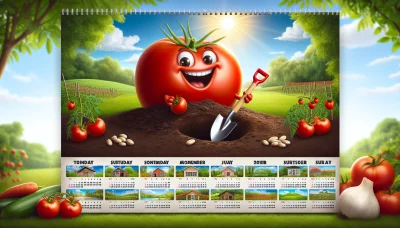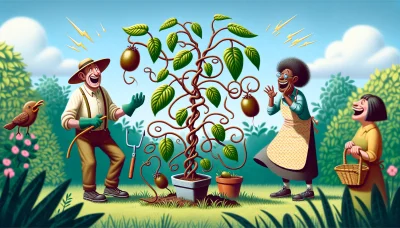Rambutan fruit taste Quiz
Test Your Knowledge
Question of
Exploring the Unique Taste of Rambutan Fruit
Rambutan is a tropical fruit that is native to Southeast Asia. It is known for its unique appearance, featuring a hairy or spiky red and green shell. Inside, the fruit resembles a lychee, with translucent white flesh that is juicy and sweet, encasing a single seed. The name "rambutan" is derived from the Malay word for hair, a nod to the fruit's distinctive, hair-like spikes. Rambutan is not only a delight to the senses with its exotic taste but also a colorful addition to the fruit basket, inviting curiosity and adventure in every bite.
How to Grow Rambutan Trees in Your Garden
Rambutan trees are a tropical delight that can bring a touch of the exotic to your garden. Originating from Southeast Asia, these trees are known for their delicious fruit and beautiful appearance. However, growing rambutan trees requires understanding their specific needs to thrive.
First and foremost, climate plays a crucial role in the successful cultivation of rambutan trees. They thrive in warm, tropical environments and are not tolerant of cold temperatures. Ideally, the temperature should not fall below 10°C (50°F), as rambutan trees are extremely sensitive to frost. A location that maintains a consistent temperature between 22°C to 30°C (72°F to 86°F) is perfect.
When it comes to soil, rambutan trees are quite adaptable but they perform best in deep, well-drained soil with a high organic matter content. The ideal pH range for the soil is slightly acidic to neutral (pH 5.5 to 6.5). Ensuring the soil is fertile and rich in nutrients will support the healthy growth of your tree.
Watering is another critical aspect of caring for rambutan trees. They require regular, consistent watering to keep the soil evenly moist, especially during the dry season. However, it is important to avoid waterlogging, as this can lead to root rot and other issues. Implementing a good drainage system can help prevent these problems.
By providing the right climate, soil, and watering conditions, you can enjoy the lush growth and delicious fruits of your very own rambutan tree. Remember, patience and care are key, as it may take several years before the trees begin to bear fruit. Happy gardening!
When and How to Harvest Rambutan
Rambutan fruits are ready for harvest when they exhibit a bright color, which can range from red to yellow depending on the variety, and the spiky "hairs" on the skin turn from green to a more vibrant hue. The fruit should feel slightly soft but not mushy when gently squeezed, indicating it is ripe. Harvesting is best done by cutting the fruit from the tree with a pair of pruning shears or a sharp knife, leaving a short piece of the stem attached to protect the fruit's integrity and prolong its shelf life. It's essential to harvest rambutan carefully to avoid damaging the fruit and to ensure it remains fresh and tasty for consumption.
Rambutan Fruit Taste Profile
The rambutan fruit offers a unique taste experience that is often described as sweet and slightly acidic, closely resembling the flavors of grapes and lychee. Its juicy and refreshing texture, combined with a creamy sweetness, makes it a favorite among exotic fruit lovers. The flesh of the rambutan is translucent and firm, similar to that of a grape but with a slightly chewier consistency. Its aroma is mildly fragrant, inviting comparisons to the delicate scent of roses, which further enhances its exotic appeal. For those familiar with lychee or grapes, the rambutan offers a delightful variation that is both exotic and familiar.
Health Benefits of Rambutan Fruit
- Rich in Vitamin C, helping boost the immune system.
- Contains natural sugars and fiber which can aid in digestion.
- Has a good amount of water, helping to keep the body hydrated.
- Provides a modest amount of iron which is essential for blood health.
- Antioxidant properties help in fighting free radicals and reducing inflammation.
- Contains small amounts of copper, which is important for bone health.
- Low in calories, making it a healthy snack for weight management.
- Potassium in rambutan can help manage blood pressure levels.
- Can contribute to healthy skin due to its Vitamin C content.
Delicious Rambutan Recipes
- Rambutan Salad with Grilled Shrimp
- Chilled Rambutan Soup
- Rambutan and Pineapple Salsa
- Spicy Rambutan and Chicken Curry
- Rambutan Cheesecake
- Coconut Rambutan Smoothie
- Rambutan Jelly
- Rambutan Stuffed with Pineapple
- Rambutan and Mixed Berry Tart
- Exotic Rambutan and Mango Salad
Tips for Storing and Selecting the Best Rambutan
When selecting the freshest rambutan at the market, look for fruits with bright red skin and lush green hairs, as these are usually the freshest. Avoid any with brown spots or ones that look dry and brittle, as these are signs of age. Once home, store your rambutan in a perforated bag in the refrigerator to maintain its freshness. They typically last about a week when stored properly. For longer storage, you can peel the fruits, remove the pit, and freeze the arils in an airtight container. This method can extend their shelf life for several months while preserving their taste and nutritional value.












